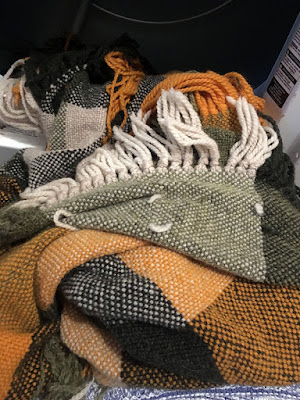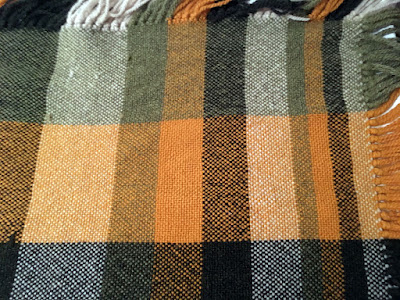This is it! The last three things I did with the blanket before I declared it completely and utterly done!
You should be excited; this means you might actually get to see photos featuring colors other than white, light green, dark green, and marigold. Well. Colors other than white, light green, and dark green. The marigold is here to stay, along with lemon, mustard, sunflower, honey, ochre, Kraft mac'n'cheese, highlighter, straw, No. 2 pencil, and gold.
 |
| Featuring my armour, because I will do fiber arts anywhere. |
I decided to add fringe to the long sides of my blanket, as well as having the loom fringe on the short ends,
to hide my wobbly selvedges because I like fringe.
I also really really struggle with "waste," and didn't want to waste the odds and ends of bobbins and too-short-to-use-but-too-long-to-toss bits of yarn. So I found a book a little wider than I wanted my finished fringe to be, and a crochet hook, and started winding! And then I restarted winding! Because when you wind springy wool yarn under tension, you lose dramatic amounts of length when it's at rest!
I inserted my shears under the wrapped yarn (I stopped when I was bored...there's a lot of blanket, and I knew I'd use what was left on the bobbin before I needed to start counting threads) and snipped it into a pile of double-length pieces. (This is where winding on a book is handy, because the covers and the pages make a neat little channel to slide your scissors into, like the slot in the cutting counter at a fabric shop.)
 |
| For someone who very rarely crochets, I own a lot of crochet hooks. |
Double-length pieces, because I was using lark's head knots to attach the fringe—my favorite for attaching cord where all or nearly all stress will be pulling on the tails. I looped one piece of fringe through each turning of weft thread, catching the outermost warp thread in the knot for better stability overall.
 |
| Loop de loop. |
This went remarkably quickly. I got all the sections of light green on one side of the blanket fringed in the time between arriving at practice and everyone else arriving and arming up.
 |
| More satisfying patterns for me. |
I also really like the neat little ridge the heads of the knots make along the edge, and they very nicely conceal my wibbles at the selvedges.
 |
| I named this file "soggy waffles." There. That's a thing you know now. |
After the long edges had been completely fringed, I got to dampen the whole blanket (or...most of the blanket. More on that later) and then
chuck it in the dryer. For real. My handwoven, 100% wool blankie went in the dryer for the first and last time in its life.
And it
fluffed. Gloriously.
The crucial bit of information here is that the blanket really was just damp, not sopping, and that it was in the dryer for only twelve minutes. That's long enough to fluff up all the fibers and full the cloth, but not long enough to felt the fringe into blocks of fuzz, nor to glue unrelated sections of blanket to each other irretrievably.
 |
| The photo does in fact make the inconsistency look better than in person. |
Unfortunately, because I didn't get the blanket damp through
everywhere, there were a few sections that didn't full—the moisture
and the heat
and the agitation are all crucial—so I had to go back and re-dampen the unfulled sections without getting the finished bits wet again. Fiddly work. You can just see, in the photo above, that the horizontal marigold stripe is a touch wider in the middle of the photo than at either end: that's an unfulled section. I found it easier to search the blanket with my fingertips than to look for visual differences; the textural change is much more dramatic.
 |
| I love wool and water. |
Okay, so there were two times it went in the dryer, but if I'd done it right the first time, it would've been once. And the second time was the charm—the whole blanket was properly fulled afterward.
 |
| My work desk counts as a tool of the trade, right? It's the largest horizontal surface I have regular access to. |
And at long last, the final bits of finish work: trimming the fringe neatly, and trimming the tails of the repair threads flush with the surface of the cloth. I did both at work, where I have access to a reasonably large horizontal surface that isn't the floor. Mostly that worked well; there were a few tricky bits that involved carefully piling the excess blanket out of the way, but still on the desk, to keep the weight of it from tugging everything to the floor.
 |
| It's even enough for government work, as my grandfather would say. |
Originally I was aiming for 4-inch fringe, but after fluffing, my side fringes shrank dramatically, and I could only just eke three inches out of them. I didn't fuss too much over getting the fringe perfectly aligned and even, and I actually just noticed a stray thread the other day that had folded up behind the blanket when I was trimming, and so avoided its fate. Temporarily. I'm coming for you, little anarchist fringelet.
 |
| This strategy did not save me from having things put in my inbox. |
I generated a lot of scrap yarn with the Great Trimmening, which obviously I couldn't bear to waste. A bunch of it
became pincushion stuffing later, but first I used it to fill my inbox.










Comments
Post a Comment